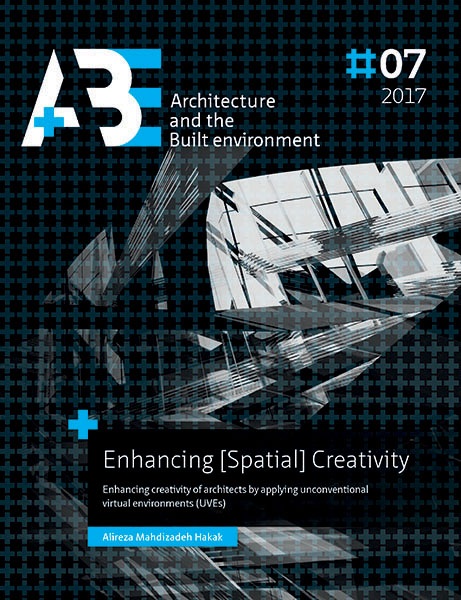Enhancing [Spatial] Creativity – Enhancing creativity of architects by applying unconventional virtual environments (UVEs)
DOI:
https://doi.org/10.7480/abe.2017.7.1803Keywords:
Creativity, Unconventional Virtual Environments, 3D modelling, 3D softwareAbstract
Potentials of virtual environment for enhancing creativity of architects have shaped this research. There is no singular definition of creativity. In fact, there are more than 100 different definitions for creativity according to different contexts and disciplines. Nevertheless, it is possible to confine the boundaries of definitions and address creativity within a confined framework.
The first practical step was thus to perform an in-depth literature survey to define a boundary condition for the widespread topic of “creativity” and identify vital research questions pertaining to creativity. In this regard, personality and behavior of creative people; mood, state, temper, intelligence vs. creativity, motivation and so forth were ignored. Instead, cognitive aspects of creativity such as thinking patterns, conceptual blending, idea expansion and tolerance of ambiguity have been focused upon.
The second step was to test whether starting a design procedure with a 2 or a 3-dimensional mode of thinking has any correlation with creativity. An experiment pertaining to this test was designed in which participants were asked to perform the same design task once with 2D tools and environments (e.g. traditional pen and paper) and the next time by applying 3D tools and environments (e.g. 3D software). A jury of experts in the field of design subjectively compared the results and arrived at a conclusion that participates generated more creative ideas by implementing 3D environments/tools.
The third step, involved the introduction of unconventional virtual environments (UVEs), which subsequently lead to the creation of a hypothesis. This hypothesis tries to connect navigation in UVEs with the enhancement of creativity. Characteristics of UVEs and theoretical arguments around the hypothesis were also discussed.
The fourth step, involved a discussion on two effective parameters of creativity:
1- Tolerance of ambiguity
2- Conceptual blending
Attempts to verify these parameters, lead to the formulation of two separate experiments. The conclusions of these experiments were as follows:
1- Tolerance of ambiguity has a direct relationship with creativity. Architects deal with multiple parameters during a typical design process. The ability to meaningfully process the relationships between such a multitude of parameters has also trained architects to possess a higher level of tolerance of ambiguity aiding them in postponing making hasty judgements.
2- By combining different ideas, one can formulate newer and much novel ideas. Ideas tend to become creative when more remote ideas are combined and synthesized. In order to prevent repetitive and self-similar ideas, the unconscious mind needs to be fed with more ideas, which the mind has not been exposed to. These new ideas/experiences can be generated by exposing one’s self to UVEs, since UVEs can expose one to situations and experiences which the brain cannot experience in the physical world.
The fifth step, aims at understanding how the brain perceives different environments. Three different environments were chosen for an experimental study pertaining to the same: 1- Abstract environment 2- Semi-designed environment and 3- Fully designed environment. Participants were asked to provide a feedback by answering a questionnaire after navigating each of these environments. Simultaneously, their brain activity patterns were recorded via a professional neuropsychology apparatus. After analyzing the brain activities, in conjunction with the questionnaire, it became clear that perception of an abstract environment is completely different from the perception of a Semi-designed or Fully designed environment. This experiment consolidated the hypothesis that UVEs as abstract designed environments activate parts of the brain that are correlate with creativity.
The sixth step, involved putting the hypothesis to a final test. A conclusive experiment was thus designed. The experiment won the Visionair fund of FP7 and was conducted in Italy. A UVE was designed using the software 3D max and was converted to 3D stereoscopic mode using a specific software: GIOVE; developed in ITIA-CNR, Italy. Using a 3D goggle and 6 axis mouse, a group of 20 participants were asked to navigate the UVE. They were asked to provide a written feedback pertaining to their feelings, expectations, strategy of navigation and in general, their experience. Their responses were collected and analyzed.
The final step, involved answering the formulated research questions and discussing the final results.

